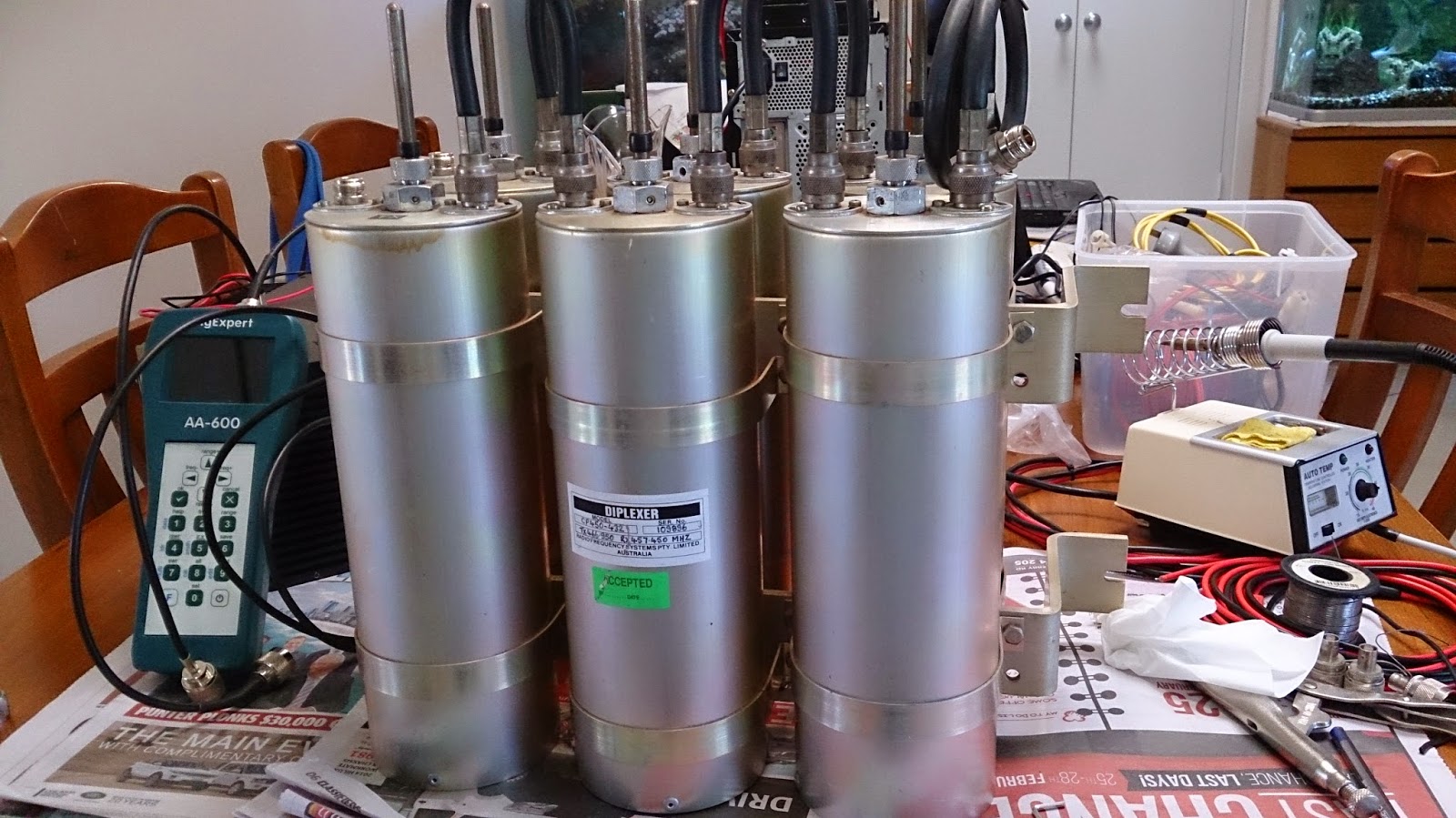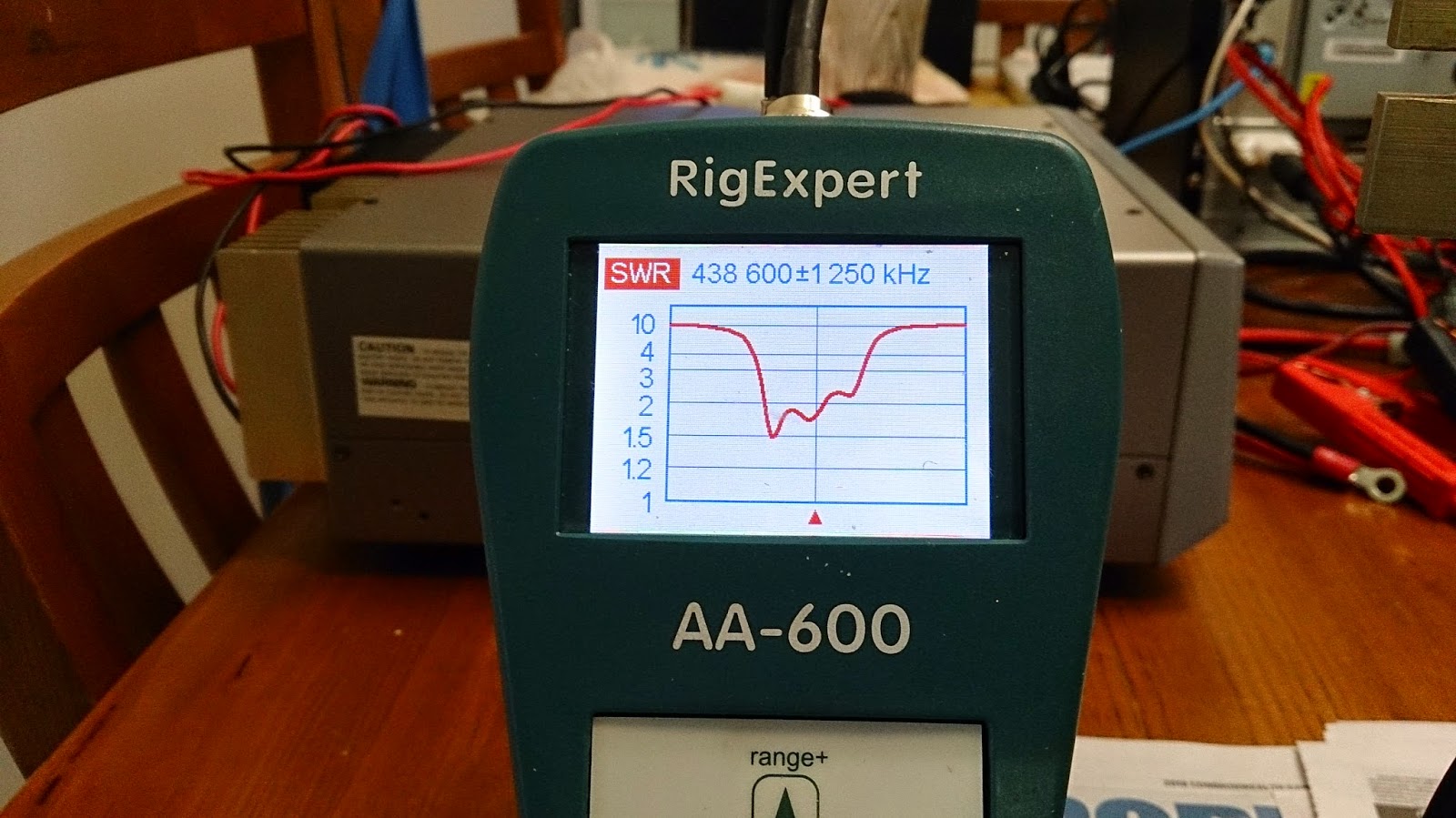Tuning a commercial UHF duplexer with RigExpert antenna analyser
Tuning a commercial UHF duplexer with RigExpert antenna analyser
The club is assembling a 70 cm repeater with some equipment kindly loaned to us to use; a Kenwood TKR-820 repeater and a good quality commercial six cavity band-pass duplexer. The tuning was done with a RigExpert antenna analyser that gives a plot of SWR swept across a frequency range. The analyser was able to tune each cavity, but the overall response, while good for separation was compromised, possibly by incorrect inter-connecting cable lengths.
Tuning the duplexer
The duplexer is a band-pass type, with six cavities, three each for RX and TX with a "T" combiner. The cavities use N connectors and thick LMR400 type cable, and are about twenty years old.The probes are set for maximum coupling, which is desirable for selectivity but for some transmission loss.
As a band-pass cavity filter, each cavity has a N connector in and out, making tuning each cavity quite easy; put a 50 Ohm termination on one side and the RigExpert analyse on the other. A typical response for a single cavity is a nice smooth curve, as you would expect.
However, once each cavity is tuned and all connected again, with a terminations on the RX and TX ports and the analyser on the antenna port, the high level of separation of the RX and TX can be seen.
The depth of each pass-band is less than that for a single cavity, plus the pass-band is not nice and smooth. This is presumably an effect of the interconnecting cables and the "T" type combiner.
The individual RX and TX pass-bands can be observed. The pass-band is sharper than for a single cavity, shown in the first photo, but the response is not as deep or as smooth.
Discussion
The most likely cause are the interconnecting cables between cavities, which are about 270 mm. My understanding is that cables should be an odd number of quarter wavelengths. At 433.6 MHz, a quarter wavelength is about 173 mm. The velocity factor of RG-213 coax is about 0.66, so the cable length should odd multiple of about 114 mm. In this case, the connecting cables are close to a half wavelength, not good for duplexer's performance.The duplexer was factory tuned for TX 466.95 and RX 457.45 MHz. For TX, the cable quarter wavelength is about 106 mm, with the cables being closer to three times a quarter wavelength. The length of the cable is a bit of a black art, often done by substituting cables of different lengths. I think the length of the cable plus some of the length of the probe inside the cavity may be the correct length.
The type of coaxial cable is very important as the velocity factor for RG-213 is 0.66, whereas for more modern and better shielded LMR400 coax, it is 0.85, a very significant difference.
Making new cables is a considerable task, especially the "T" combiner, as it is custom made. For LMR400 cable, 147 mm is too short for thick cable, thus requiring three times a cable quarter wavelength or about 441 mm. Thinner cable may allow a quarter wavelength.
Conclusion
For the moment, I think we shall use the duplexer as-is and see if it has any practical issues. The separation is good, but the transmission losses may be too high, especially for an aged repeater with 5 W output and aged RX frontend.The RigExpert is a very convenient instrument for tuning the cavities, however a tracking spectrum analyser may be needed to measure the overall duplexer's performance, particularly transmission. losses. I have a portable one and the club has a desktop spectrum analyser, so we may use them another day.






This comment has been removed by the author.
ReplyDeleteThis comment has been removed by the author.
ReplyDeleteSo how did the unit work after tuning? We have a VHF duplexes purchaced for the ham band, but after 20years and a move it seems to need re-tuning.
ReplyDeleteHi. Now I would use a spectrum analyser and tracking generator. Do one can at a time. Check all your cables and connectors. Often they come loose when moved. Drew
ReplyDeleteVery Interesting discussion. I think �� I will give your method a go on an old 3 cavity UHF Sinclair that I picked up recently to try out with my DR-1X. Not sure how it will end up, but if I have no positive results, I do have a source to help me get it lined up with the correct tools. I am hopeful and love to tinker and learn as I go.
ReplyDeleteMy cans were tuned just a about 3MHZ above where I need them to be. For additional info, TX is 442.175 and RX is 447.175. W4SML
If anyone has any ideas or warnings, please feel free to share. No hard feelings, that’s how we learn new things.